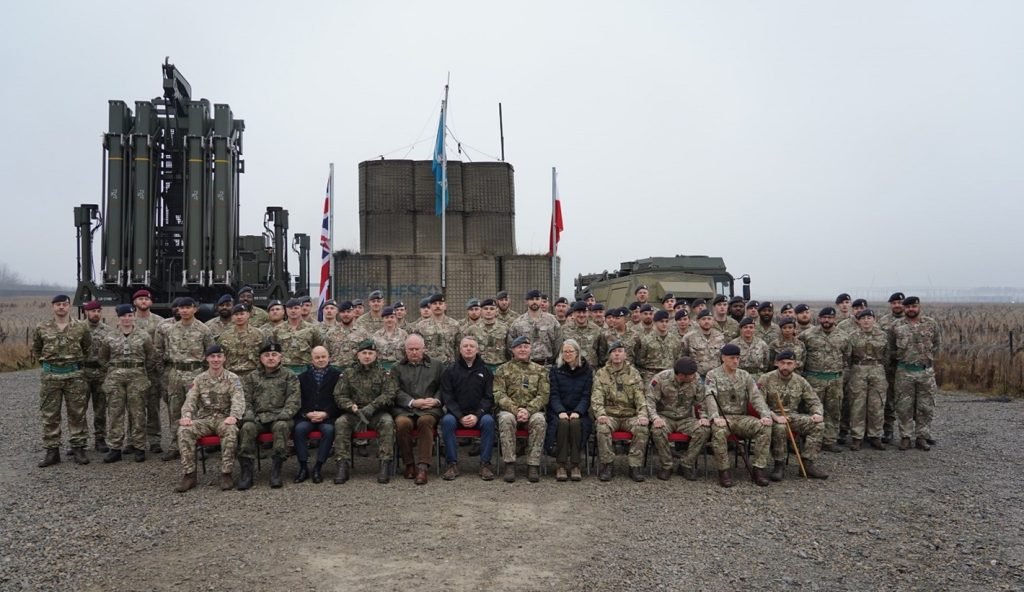
The British Army will begin to send its Sky Sabre ground-based air defence (GBAD) system back home to be reconstituted in the UK after two years and eight months of service in Poland.
This single Sky Sabre unit, and its Royal Artillery operators, were sent to protect Polish airspace on Nato’s eastern flank in April 2022, less than two months after Russia invaded Ukraine on 24 February that year.
In order to compensate the Poles for the loss of the system, the Ministry of Defence (MoD) confirmed that the Royal Air Force will deploy Eurofighter Typhoons to the country in 2025 as part of the Nato air policing initiative.
The MoD declined to comment at this time on the number of aircraft or the date they will arrive in Poland.

Return to the UK
In the first instance, when the system has returned to the UK, the GBAD system will undergo maintenance and repairs. The MoD were unable to note where the system will be based in the UK going forward; however more precise details regarding its transit will come before the end of 2024.
Notably, Sky Sabre’s return appears to be prompted by the need to ensure that the UK armed forces “have flexibility on operational requirements in the future.” Especially to train more personnel on the system, according to a press release issued by the MoD on 12 December.
Access the most comprehensive Company Profiles
on the market, powered by GlobalData. Save hours of research. Gain competitive edge.

Company Profile – free
sample
Your download email will arrive shortly
We are confident about the
unique
quality of our Company Profiles. However, we want you to make the most
beneficial
decision for your business, so we offer a free sample that you can download by
submitting the below form
By GlobalData
Sky Sabre use in Poland
A Sky Sabre system comprises three main sections: the brain (a Rafael command and control (C2) system), the sensor (a Saab Griaffe Agile Multibeam Radar), and the missile system (MBDA’s Land Interceptor launcher that fires CAMM missiles).
These latest GBAD units were acquired from as early as 2021 to replace several legacy Rapier systems which entered service back in the early 1970s, according to GlobalData’s UK Defence Market report.

The Army currently operate six Sky Sabre systems. One is based in the Falkland Islands in the South Atlantic, while the return of the Polish-based system will bring the number of systems in the UK back up to five.
The system is said to be accurate enough to hit a tennis ball-sized object travelling at the speed of sound. Its can control up to 24 missiles simultaneously in flight, guiding them to each hit separate targets.
For almost three years now Sky Sabre served to protect Poland while the country began a behemoth plan to expand and integrate a layered air defence network.
Under the ‘WISŁA’ programme, or Vistula in English – named after the river upon which the plan was first signed – the Polish government acquired numerous Patriot batteries in the 3+ configuration with Northrup Grumman’s Integrated Battle Command System (IBCS).
The IBCS connects sensors and effectors never designed to work together in one C2 system. This expanded air defence network will also include MBDA UK’s CAMMs and 22 PILICA+ air defence batteries, acquired last year for nearly £2bn ($2.5bn).
The UK will need to form an integrated and layered air defence network alongside its European counterparts too, noted Jack Watling and Sidharth Kaushal, land warfare specialists, in a Royal United Services Institute report in April 2024.
“Army GBAD must be able to both draw on and contribute to a joint and alliance-level recognised air picture that enables assets organic to manoeuvre formations to leverage data from higher echelons (and vice versa).”
At present, the UK’s six Sky Sabre GBAD units, while effective interceptors, operate individually and not in consort.









